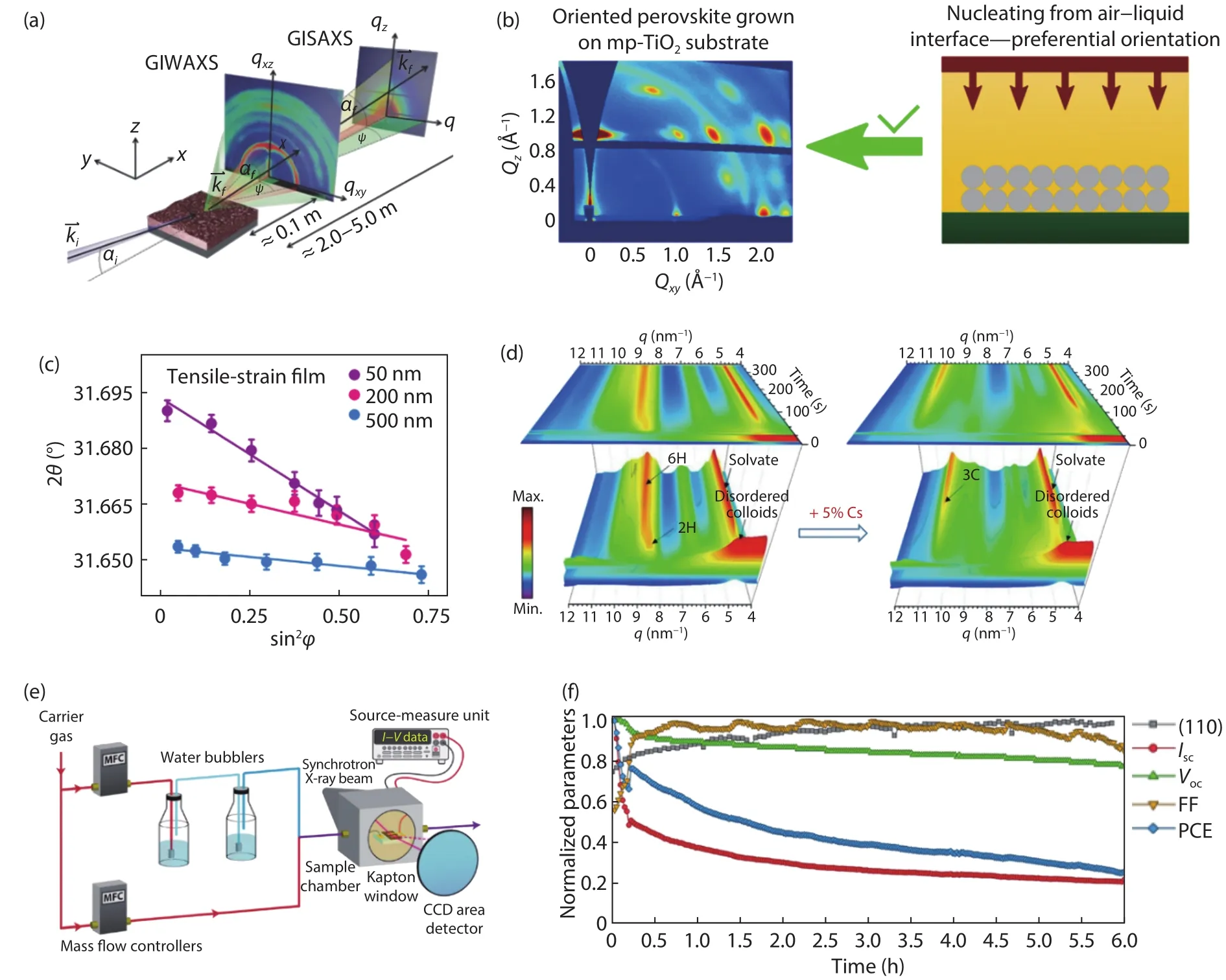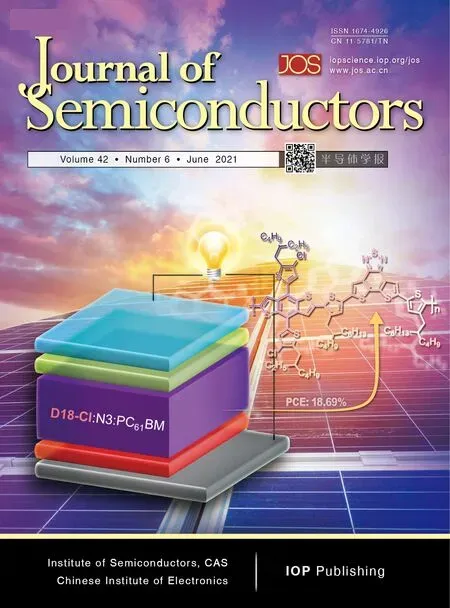GIWAXS:A powerful tool for perovskite photovoltaics
Chenyue Wang, Chuantian Zuo, Qi Chen, , and Liming Ding,
1MIIT Key Laboratory for Low-dimensional Quantum Structure and Devices, Experimental Center of Advanced Materials, School of Materials Science and Engineering, Beijing Institute of Technology, Beijing 100081, China
2Center for Excellence in Nanoscience (CAS), Key Laboratory of Nanosystem and Hierarchical Fabrication (CAS), National Center for Nanoscience and Technology, Beijing 100190, China
The power conversion efficiency (PCE) for perovskite solar cells (PSCs) now reaches 25.2%[1].However, the perovskite materials have complex compositions and variable phases,calling for suitable characterization techniques to investigate the underlying operation and degradation mechanism.Grazing-incidence wide-angle X-ray scattering (GIWAXS) plays an important role in studying perovskite materials.GIWAXS data are generally two-dimensional diffractograms containing diffraction rings of different crystal planes.Grazing-incidence small-angle X-ray scattering (GISAXS) is similar to GIWAXS,while it has a longer detection distance than that of GIWAXS(Fig.1(a))[2].GISAXS enlarges the observable spatial range up to 10–100 nm and reduces the measurement sensitivity of crystallization, and it is mainly used to determine the morphology of bulk-heterojunction films in nanoscale[3,4].Compared to GISAXS, GIWAXS is more popular in perovskite study.This technique has several advantages as follows:(1) high signalto-noise ratio (SNR) and sensitive structural resolution; (2) nocontact and nondestructive probing; (3) abundant structural information; (4) depth resolution; (5)in-situobservation.Here,we discuss two applications of GIWAXS, i.e., the crystallographic information at steady state, and thein-situmeasurement to probe the temporal information.As an important structural parameter of perovskite films, crystallographic orientation affects the optoelectronic properties and materials stability.The 2D GIWAXS diffractogram presents the Debye-Scherrer ring for certain crystallographic plane, enabling characterization of structural orientation of perovskite films.The orientation degree for crystal planes can be obtained quantitatively according to the diffraction rings along the azimuth by using Herman’s orientation function.
Quasi-2D perovskites receive attention due to their variable structures, tunable composition, and relatively high stability.The insulating organic long-chain cations in quasi-2D perovskites can block carrier transport.Suitable crystal orientation can enhance the carrier transport in 2D perovskites, thus improving device performance.GIWAXS measurements give information about crystal orientation, it can also tell the stacking manner of grains at different depths, which is essential for understanding the crystallization mechanism.For example, by using GIWAXS, Choiet al.found that the nucleation and crystallization of BA2MA3Pb4I13perovskite occurs at the gas-liquid interface during annealing, which results in the vertical alignment of 2D perovskite crystals (Fig.1(b))[5].They further regulated the solvent and cation to prepare highly vertically orientated 2D perovskite films[6].Rafaelet al.found that the intermediate solvent complexes provide building blocks in the formation of 2D perovskites according to GIWAXS measurements[7].
High-quality 3D perovskites tend to make strong orientation at certain azimuth angle.GIWAXS results can be used to evaluate the crystallization quality of 3D perovskite thin films.The results can also be used to guide the process optimization, as well as to clarify the relationship between crystallographic orientation and device performance.Zhenget al.regulated the preferential orientation of perovskite crystals and improved the interfacial carriers transport in the corresponding devices by substituting A-site alkali metal cations[8].
Recently, residual strain was observed in perovskite films due to the mismatch of the expansion coefficients for the substrate and perovskites, which influences the operational stability and efficiency of perovskite solar cells.Microscopically, the residual stress within the film results from a biaxial stretching of the perovskite lattice in in-plane direction.The shift of corresponding diffraction peaks at different azimuthal angles reveals the lattice tilting and stretching.By depth-resolved GIWAXS, Zhuet al.observed a gradient strain in FA-MA perovskite films (Fig.1(c)).The performance of PSCs was improved by reducing lattice mismatch of the crystals[9].Wanget al.replaced A-site cations on the perovskite surface by using OAI post-treatment, forming a “bone-joint” configuration,reducing surface residual stresses and thus improving humidity and thermal stability of PSCs[10].
In-situmeasurement is attractive in perovskite research.It provides a rapid approach to track microstructural changes in perovskite materials, including the crystallization and aging processes.It is the key to unravel the kinetics process of perovskite materials.The formation process of perovskite crystals is not fully understood yet.The film formation process includes liquid-film gelation stage and crystallization stage.Many studies have shown that the orientation and phase structure of perovskite are already established during gelation stage.The quality of the perovskite precursor film(gel) significantly affects the final perovskite film.In-situGIWAXS provides information for the composition evolution during spin-coating process.It also provides guidelines for preparation conditions, such as spin speed and time, dripping time of anti-solvent, etc.Amassianet al.have conducted a series ofin-situGIWAXS studies on perovskite.They observed the transition of perovskite precursors from liquidphase to sol–gel state, and investigated the effect of precursor spin-coating time on PSCs performance[11].They revealed that Cs+and Rb+cations were able to stabilize the sol–gel state and suppress the phase separation during spin-coating(Fig.1(d))[12,13].

Fig.1.(Color online) (a) Schematic diagram of GIWAXS and GISAXS.Reproduced with permission[2], Copyright 2017, John Wiley & Sons Inc.(b) Schematic diagram of the formation of vertically orientated 2D perovskite.Reproduced with permission[5], Copyright 2018, Nature Publishing Group.(c) Gradient strain at different depths in perovskite layer.Reproduced with permission[9], Copyright 2019, Nature Publishing Group.(d) Time-resolved GIWAXS for precursor films with and without K+ during spin-coating.Reproduced with permission[13], Copyright 2019, Elsevier Inc.(e) Humidity control set-up.(f) Time-dependence for MAPbI3 (110) peak area and device performance parameters.(e) and (f), reproduced with permission[15], Copyright 2018, American Chemical Society.
GIWAXS can also be used to study the crystallization process during thermal annealing.Using the peak area integrated by the Debye-Scherrer ring of GIWAXS, all the phase contents of perovskites and their evolution during annealing can be deduced, which illustrates the phase transition from intermediate phase to perovskite phase.The activation energies for perovskite formation can be determined by using Arrhenius equation.
Perovskite degradation caused by humidity and heat limits the commercialization of PSCs.In conjunction with the moisture and temperature controller, the aging process of devices under different conditions can be monitored by GIWAXS.Through depth-resolved characterization, the physical and chemical reactions at different positions can be deduced by combining with other characterizations, which will reveal the degradation mechanisms.Kellyet al.performed systematicin-situGIWAXS studies on perovskite degradation.They observed that MAPbI3films decomposed to a hydrated intermediate phase with PbI64–octahedra in a humid environment[14].To further investigate the performance and structure changes of PSCs under humidity, they developed a humidity controller in conjunction withI–Vmeasurement system (Fig.1(e)).The results revealed that the decrease of performance results from the electrode corrosion, rather than perovskite decomposition (Fig.1(f))[15].
In summary, GIWAXS has been widely used to reveal the relationship between perovskite crystal structure and device performance.In-situGIWAXS can be used to track the crystallization process and decomposition process of perovskites.This method can help us to develop stable and efficient perovskite solar cells.
Acknowledgements
This work was supported by National Natural Science Foundation of China (21975028, 22011540377), Beijing Municipal Science and Technology Project (Z181100005118002),and Beijing Municipal Natural Science Foundation (JQ19008).L.Ding thanks the National Key Research and Development Program of China (2017YFA0206600) and the National Natur-al Science Foundation of China (51773045, 21772030,51922032, 21961160720) for financial support.
 Journal of Semiconductors2021年6期
Journal of Semiconductors2021年6期
- Journal of Semiconductors的其它文章
- Oscillation neuron based on a low-variability threshold switching device for high-performance neuromorphic computing
- A 3.3 kV 4H-SiC split gate MOSFET with a central implant region for superior trade-off between static and switching performance
- Determination of trap density-of-states distribution of nitrogendoped ultrananocrystalline diamond/hydrogenated amorphous carbon composite films
- 3.3 kV 4H-SiC DMOSFET with a source-contacted dummy gate for high-frequency applications
- Heavily doped silicon:A potential replacement of conventional plasmonic metals
- Modeling the photon counting and photoelectron counting characteristics of quanta image sensors
